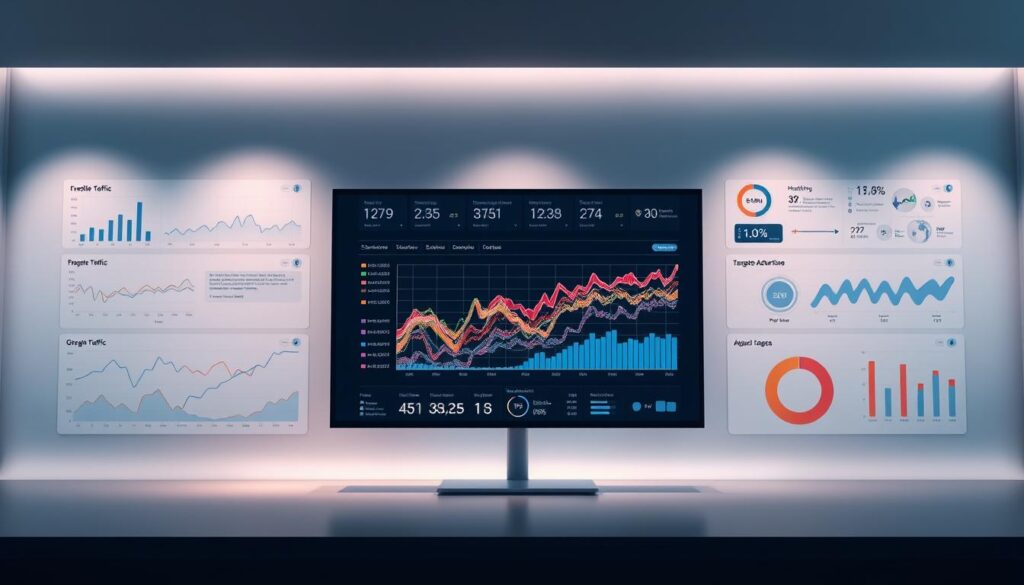You’ve seen it happen. Your competitors show up everywhere when people search for what you offer. But your business is nowhere to be found, your phone is quiet, and chances are slipping away.
Here’s the truth: 90% of people start their search with Google. If you’re not on page one, you’re invisible. Most people don’t look beyond the first page. So, your competitors get all the attention while you watch.
This traffic gap isn’t a coincidence. It’s because your competitors have a plan, and you haven’t. Every time someone finds a competitor first, you lose a chance. And you’re tired of seeing your competitors online while you’re not.
The bright side? You can catch up. Just understand what your competitors are doing right and what you’re missing. This guide will help you even the playing field.
Key Takeaways
- Over 90% of customers start their search on Google, making first-page rankings key for survival
- Most users don’t look beyond the first page, giving top-ranked competitors a big edge
- The traffic gap between you and competitors comes from specific strategies, not luck or budget
- Knowing what your competitors do can help you improve your online presence
- Every time a competitor appears first, it’s a lost lead and a missed customer for you
- Closing the visibility gap needs data-driven strategies, not guesses or old marketing ways
1. Understanding the Online Traffic Gap
Many business owners find out about their traffic problem too late. The digital world is all about visibility. If people can’t find you, they can’t hire you. The first step is to admit you have a problem and understand its size through data.
Some businesses think their website is fine, but the data tells a different story. Without checking your website’s traffic, you’re driving blind.
“What gets measured gets managed.”
Recognizing the Warning Signs of Poor Traffic Performance
If your website is struggling, you might notice some signs. For example, if fewer people are visiting your site or engaging with your content, it’s a problem.
Look out for these warning signs:
- Minimal website visits compared to before or what others are doing
- Poor search result positions for keywords that should be good for your business
- Low engagement rates with visitors leaving fast without looking around
- Decreasing conversion rates even though you’re not changing what you offer
- Competitor visibility getting more attention for your target keywords
These signs show you need to act fast. Ignoring them means losing ground to your competitors every day.

How to Measure Your Current Traffic Baseline
To find out where you stand, use tools like Google Analytics and Google Search Console. These tools make complex data easy to understand and focus on what’s important for your business.
Start by looking at your website’s traffic over the last few months. Check total visitors, page views, bounce rate, and how long visitors stay.
Understanding these numbers helps you spot trends and issues. For example, if many visitors leave quickly, it might mean they’re not finding what they want.
Identifying and Analyzing Your Top Competitors
To make a good plan, you need to know who you’re up against online. Competitive benchmarking shows who’s ahead of you and why.
Use tools like SEMrush or Ahrefs to learn about your competitors’ traffic sources, best content, and keywords. This helps you see where you’re missing out.
A detailed content gap analysis shows where competitors get traffic you don’t. Knowing this is essential for making targeted improvements.
By the end of this, you’ll know where you are. This knowledge is the first step to making changes that will help your business grow.
2. Decoding Your Competitors’ SEO Strategies
Why do your competitors rank higher? They use proven SEO tactics that bring real results. By understanding their keyword research, content optimization, and technical skills, you can close your traffic gap. Let’s explore the strategies that give them an edge.
2.1 How They Conduct Keyword Research and Selection
Your competitors don’t guess which keywords to target. They use systematic research to find opportunities. A SEO competitor analysis guide shows the keywords driving traffic to their sites. This helps you find gaps in your content and spot overlooked keywords.
They aim for a mix of competitive and conversion-focused keywords. This strategy builds a strong keyword portfolio.
2.1.1 Targeting High-Value Long-Tail Keywords
Smart competitors focus on long-tail keywords. These are specific phrases with three or more words that meet user needs. Instead of targeting “plumber,” they aim for “emergency plumber in downtown Chicago” or “24-hour residential plumbing services near me.”
Long-tail keywords convert better than generic terms. For example, someone searching for “best CRM software for real estate agents under $100” is closer to buying than someone searching for “CRM software.”

Your competitors analyze the intent behind each keyword. They know searchers have different needs: informational, navigational, commercial, and transactional.
For “how to fix leaky faucet,” they create detailed how-to content. For “buy kitchen faucet online,” they optimize product pages with pricing and purchase options.
“Understanding search intent is the difference between ranking and converting. You can have all the traffic in the world, but if it doesn’t match what visitors actually want, you’ve accomplished nothing.”
2.2 Their On-Page Optimization Tactics
Once competitors find the right keywords, they optimize their pages. They use on-page techniques that signal relevance to search engines. Every element has a purpose in the ranking algorithm.
2.2.1 Title Tags and Header Optimization
Your competitors craft title tags with primary keywords in the first 60 characters. They make titles like “Emergency Plumbing Services Chicago | 24/7 Licensed Plumbers” instead of “Home | ABC Plumbing Company.”
They structure headers (H1, H2, H3) to create a logical content hierarchy. The H1 tag includes the main keyword, H2 tags cover major subtopics, and H3 tags break down specific points. This helps both readers and search engines understand the content.
They also optimize meta tags to improve click-through rates. Meta tags are the descriptions that appear under search results.
2.2.2 Strategic Keyword Placement
Successful competitors place keywords naturally throughout their content. They include target terms in the first 100 words and use variations in subheadings. They also incorporate related phrases throughout the body text.
They optimize image alt text, URL slugs, and internal links with relevant keywords. Every page element becomes an opportunity to reinforce topical relevance without compromising readability or user experience.
2.3 Advanced Implementation of Structured Data
Your top-performing competitors use structured data (schema markup). This code helps search engines understand content context and display enhanced results. This technical advantage creates eye-catching search listings with star ratings, pricing, availability, FAQ snippets, and other rich elements.
When their restaurant listing shows “Open now • $$ • 4.8★ (324 reviews)” directly in search results, they capture attention before users even click. This advanced SEO strategy transforms ordinary listings into compelling, information-rich entries that stand out from basic blue links.
The combination of strategic keyword research, meticulous on-page optimization, and structured data implementation creates a powerful SEO foundation. These aren’t isolated tactics—they work together as an integrated system that consistently outperforms basic approaches.
3. Why Their Content Outperforms Yours
Content that doesn’t engage is just expensive fun. Your rivals know how to make content that works. Before they post anything, they ask three key questions. Who is this for? What job does this content need to do? And is content marketing the right tool for this goal?
Not all content is the same. Your rivals know this and make content that really helps. They aim to solve problems for customers while meeting their business goals.

3.1 Creating In-Depth, Thorough Content
Successful rivals don’t just write shallow articles. They create detailed content that makes them the go-to experts. They’re not just another website.
3.1.1 Covering Topics Fully
They dive deep into topics. Before writing, they research and find gaps in existing content. This makes their content stand out.
They make pillar content that’s the ultimate guide on certain topics. This shows they’re experts, which search engines and people trust. This trust turns visitors into customers.
3.1.2 Answering Related Questions
Top content answers all related questions users might have. They look at “People Also Ask” boxes and related searches. This helps them understand the full search journey.
By answering these questions, they keep visitors interested longer. This reduces the need for users to search again. This approach boosts rankings and shows they’re thought leaders.
3.2 Optimizing for User Engagement Metrics
Search engines watch how people interact with your content. They look at time on page, bounce rate, and pages per session. Many businesses ignore these important factors.
Your rivals focus on these metrics on purpose. They know that just being technically perfect isn’t enough. Visitors need to stay on your site.
3.2.1 Reducing Bounce Rate Through Better Content
Lowering bounce rate is about giving real value. It’s about matching what users want when they click from search results. It’s not about tricks.
Successful rivals start with strong introductions. They use formatting and clear value to keep readers interested. This encourages them to keep reading.
3.2.2 Keeping Content Fresh with Regular Updates
Search engines like content that’s up to date. Your rivals keep their content fresh. They add new info, stats, and examples to their pages.
Regular updates show your business is active and authoritative. This keeps your content alive and can improve rankings for pages that have dropped.
3.3 Incorporating Visual Elements and Multimedia
Using visuals and multimedia makes content more engaging. Your rivals know people learn in different ways. They use images, infographics, videos, and tools to help.
These elements improve time on page and user experience. They make complex ideas clear and break up text. This makes content more enjoyable and effective.
Multimedia also helps with image and video searches. This brings in traffic from different search channels. It’s a smart way to reach more people.
| Content Approach | Your Current Strategy | Competitor’s Winning Strategy | Impact on Performance |
|---|---|---|---|
| Content Depth | 500-800 word articles covering basics | 1,500-3,000 word guides | Higher rankings and authority |
| Update Frequency | Published once, never revisited | Quarterly updates with fresh data | Sustained search visibility |
| Visual Integration | Stock photos only | Custom graphics, videos, infographics | 300% longer time on page |
| Question Coverage | Addresses one main topic | Answers 8-12 related questions | Captures long-tail searches |
4. The Technical SEO Advantages They’re Leveraging
Every top website has a strong technical base that owners often overlook. While you’ve worked on great content, your rivals have focused on the tech that makes everything run smoothly. This invisible advantage affects how search engines see and rank their sites.
Technical SEO is more than just pleasing algorithms. It’s about making your site fast, secure, and easy to use. This keeps visitors interested. Your rivals know this, and it’s helping them rank higher in searches.
4.1 Superior Website Speed and Core Web Vitals
Google now uses Core Web Vitals to rank sites. These metrics measure how well users experience your site. Slower sites get penalties.
Studies show 53% of mobile users leave if sites take over three seconds to load. Faster sites are more visible and make more money. Every second delay costs you visitors and sales.
Largest Contentful Paint (LCP) shows how fast your main content appears. Top sites have LCP scores under 2.5 seconds. This means visitors see content quickly, cutting down on leaving your site.
4.1.2 Improving First Input Delay
First Input Delay (FID) checks how fast your site responds to user actions. Your rivals have made their sites react quickly, under 100 milliseconds. This makes for smooth, enjoyable browsing.
4.2 Mobile-First Design and Responsiveness
Google now indexes sites based on their mobile version. With over 60% of searches on smartphones, mobile optimization is key.
Your rivals’ sites work well on all devices. Whether on phones, tablets, or desktops, visitors get a great experience. This keeps them engaged and interested.
4.3 Strategic Site Architecture and Internal Linking
Good site structure helps both users and search engines find what they need. Your rivals have organized their sites well. This makes it easy for visitors to find what they’re looking for.
They use smart internal linking to connect pages. This helps search engines understand your site’s content and share ranking power. Many businesses use professional optimization services to get this right.
4.4 Implementing Security and Trust Signals
Website security is now a must for good rankings. HTTPS encryption keeps user data safe and builds trust. Non-secure sites get warnings from browsers, hurting their reputation.
Your rivals show off security badges and trust seals. These reassure visitors and meet search engine needs. Fast loading and mobile friendliness complete the technical SEO foundation.
5. Step-by-Step Guide to Improve Your Online Visibility
Knowing what to do and actually doing it are two different things. You know what your competitors do well, but turning that into results takes a plan. This guide breaks down the process into steps that build momentum over time.
SEO builds long-term value and brings steady traffic growth. It’s like a smart investment that grows in value over time. Most businesses start seeing real results in 3-6 months, with even more growth after that.
5.1 Step 1: Conduct a Complete SEO Audit
Your journey starts with knowing where you stand today. An SEO audit checks your website’s performance in all key areas. It sets a baseline and shows you where you can make the biggest impact.
This detailed review finds technical issues and content gaps. It’s like a health check for your website. You can’t fix problems you don’t know about.
5.1.1 Technical SEO Checklist
Your website’s technical setup affects how search engines see it. Use this checklist to check important elements:
| Technical Element | What to Check | Target Standard | Impact Level |
|---|---|---|---|
| Page Speed | Load time across devices | Under 3 seconds | High |
| Mobile Responsiveness | Display and function on smartphones | Fully adaptive design | Critical |
| Broken Links | 404 errors and redirect chains | Zero broken links | Medium |
| XML Sitemap | Complete and submitted to search engines | All pages included | High |
| Security Protocols | HTTPS implementation status | Full SSL certificate | Critical |
5.1.2 Performing Content Gap Analysis
A content gap analysis shows topics and keywords your competitors rank for but you don’t. This process finds specific opportunities to grab traffic from rival sites.
Start by finding search queries that bring visitors to competitor sites but not yours. Use tools for content SEO analysis to find these gaps. Then, make a list of these opportunities based on search volume and relevance.
5.2 Step 2: Develop a Winning Content Strategy
Random content won’t close the traffic gap. You need a content strategy that shows your expertise and meets audience needs.
This organized approach makes sure every piece of content has a purpose. It builds on previous work to improve your visibility. Consistency is key, not just occasional posts.
5.2.1 Building Topic Clusters and Pillar Pages
Topic clusters and pillar pages create a structure that search engines love. Your pillar page covers a broad topic, while cluster content dives into specific subtopics.
Use strategic internal linking to connect these pieces. This shows search engines you’re an authority on the topic, not just on keywords. Focus on 3-5 core topics and build clusters around them.
5.2.2 Creating Your Content Production Calendar
A realistic content calendar ensures you publish regularly without overwhelming your team. Plan both new content and updates to existing pages.
Quality is more important than quantity. Two exceptional pieces a month are better than ten mediocre ones. Schedule content when your team is available, not during busy times.
5.3 Step 3: Optimize Your Website User Experience
Attracting visitors means nothing if they leave quickly. User experience optimization keeps visitors engaged, reducing bounce rates and improving chances of conversion.
Make your website easy to use and fast. Every extra second of load time increases abandonment rates. Confusing navigation sends visitors back to search results, often to competitors.
5.3.1 Improving Navigation and Site Structure
Good website navigation helps visitors find what they need easily. Organize your menu logically and limit top-level categories to 5-7 items. Make sure critical pages are accessible within three clicks from your homepage.
Use breadcrumb navigation to help users understand their location. Clear category labels and a prominent search function help visitors find what they’re looking for.
5.3.2 Enhancing Page Load Times
Speed affects both search rankings and user satisfaction. Compress images, minimize code, and use browser caching to reduce server requests.
Consider using a content delivery network (CDN) to serve resources closer to your visitors. Even small speed improvements lead to more engagement and conversions.
6. Building Domain Authority Through Strategic Link Building
Building domain authority needs a careful plan to get quality backlinks. These links show search engines you’re credible. Your competitors know that building reputation through strategic connections boosts their rankings more than any single tactic.
When big websites link to your content, search engines see it as a vote of confidence. This means they think you’re an expert in your field.
Not all backlinks are equal. A link from a respected industry publication is more valuable than many from low-quality sites. Knowing this helps you choose the right link building strategies.
6.1 How to Earn High-Quality Backlinks
The best backlink building focuses on creating genuine value. This attracts links naturally. It makes your website a go-to resource.
6.1.1 Guest Posting on Industry-Relevant Websites
Writing for established platforms is a win-win. You reach new people and get links back to your site. Choose sites that match your audience and have high standards.
Good guest posting means finding publications your customers read. Offer unique ideas that solve problems for their audience. Make sure your bio links to relevant content on your site.
6.1.2 Executing Digital PR Campaigns
Digital PR gets you media coverage and backlinks with newsworthy content. Answer journalist questions on platforms like HARO. Build relationships with journalists who cover your industry.
Share original research or unique perspectives that journalists want. When they cite you, they often link to your site.
6.1.3 Creating Link-Worthy Content Assets
Make resources that other sites want to link to. Guides, research, tools, or infographics are great for this. They keep getting links long after they’re published.
Find gaps in your industry where there’s no good resource. Create the best resource on that topic. Make sure it’s more valuable than anything else out there.
6.2 Leveraging Social Proof and Customer Reviews
Customer reviews on Google Business Profile and other sites build trust. They also help your SEO. Encourage happy customers to share their experiences.
Social proof shows credibility to customers and search engines. Use testimonials, case studies, and user content to prove your expertise.
6.3 Developing Strategic Industry Partnerships
Working with complementary businesses and organizations creates link opportunities. Partner with businesses that serve similar audiences. Work together on content, events, or resources.
These partnerships grow your network and get you authentic backlinks. Join trade associations and sponsor local events to get more links.
Focus on ethical, sustainable approaches for long-term success. Search engines reward genuine relationships and quality content. Avoid manipulative link schemes.
7. Measuring Your Progress and Refining Your Approach
You’ve made changes to your website, but how do you know if they’re working? Without proper measurement, you’re operating blind.
The truth is that digital marketing provides real data on what customers want. This lets you make smarter business decisions. This section will teach you how to track results, understand success, and make adjustments that improve over time.
7.1 Setting Up Essential Analytics Tools
Before you can measure progress, you need the right analytics tools. These tools are like your digital dashboard, showing you what’s happening on your website and in search results.
The good news? The most powerful tools are completely free.
7.1.1 Configuring Google Analytics and Search Console
Google Analytics tracks how visitors interact with your website. It shows you which pages people visit, how long they stay, and what actions they take.
Setting it up takes about 15 minutes. You’ll create an account, add a tracking code to your website, and verify it’s working properly.
Google Search Console reveals how your site appears in search results. It identifies technical issues, shows which queries bring visitors, and highlights opportunities for improvement.
Together, these platforms provide insights into your website performance and search visibility.
Rank tracking software monitors where your website appears for specific keywords over time. This data shows whether your optimization efforts are moving you up in search results.
Popular options include SEMrush, Ahrefs, and Moz. These tools automatically check your positions daily and alert you to significant changes.
7.2 Monitoring Critical Performance Indicators
Once your tools are configured, focus on the performance metrics that matter for your business. Not all data is equally valuable.
7.2.1 Tracking Organic Traffic Growth
Organic traffic represents visitors arriving through search engines. This metric shows your improving visibility and relevance.
Watch for steady upward trends. Meaningful growth typically appears over weeks and months, not overnight.
Compare current periods to previous ones—month over month or year over year. This context reveals true progress beyond seasonal variations.
7.2.2 Analyzing Keyword Rankings and SERP Position
Your keyword rankings show which search terms are bringing visitors. Track both your target keywords and unexpected phrases that generate traffic.
Pay special attention to your SERP position for high-value terms. Moving from position 8 to position 3 can double or triple your traffic for that keyword.
Identify which content pieces are climbing and which need additional optimization. This guides your refinement efforts.
7.3 Implementing Continuous Testing and Optimization
Measurement without action accomplishes nothing. The real power comes from continuous optimization based on your findings.
A/B testing lets you compare different approaches systematically. Test headlines, content formats, or page layouts to discover what resonates with your audience.
Working with experts means having a team that watches rankings closely, optimizes website structure, creates search-friendly content, and monitors performance with monthly strategy adjustments. This approach, combined with AI conversion optimization, transforms data into actionable improvements that drive measurable results.
Remember: successful businesses treat online visibility as an ongoing process, not a one-time project. Regular analysis and refinement compound your advantages over competitors who set and forget their strategies.
8. Conclusion
The gap in traffic between you and your competitors is not permanent. It’s because they’ve used certain strategies you can also use. Now, you know their methods and have a plan to catch up.
SEO is no longer optional. It’s key to being seen online today. Customers look for businesses online, and if they can’t find you, they’ll go elsewhere. The digital world is changing fast, and not being found online means losing ground every day.
You don’t need to be an expert overnight or spend a lot of money. Start by auditing your site to find big opportunities. Focus on changes that give you a strong edge. Most businesses see real results in three to six months with steady effort.
The strategies you’ve learned lead to lasting growth. Each improvement adds to the next, making your business more visible and attracting better leads.
Your skills and services should be found by customers looking for what you offer. The choice is yours: act now or let competitors take more business. Your online presence starts with the first step you take today.

